MXA RACE TEST: 2017 KAWASAKI KX450F — THE HONEY-DO LIST
Click on images to enlarge
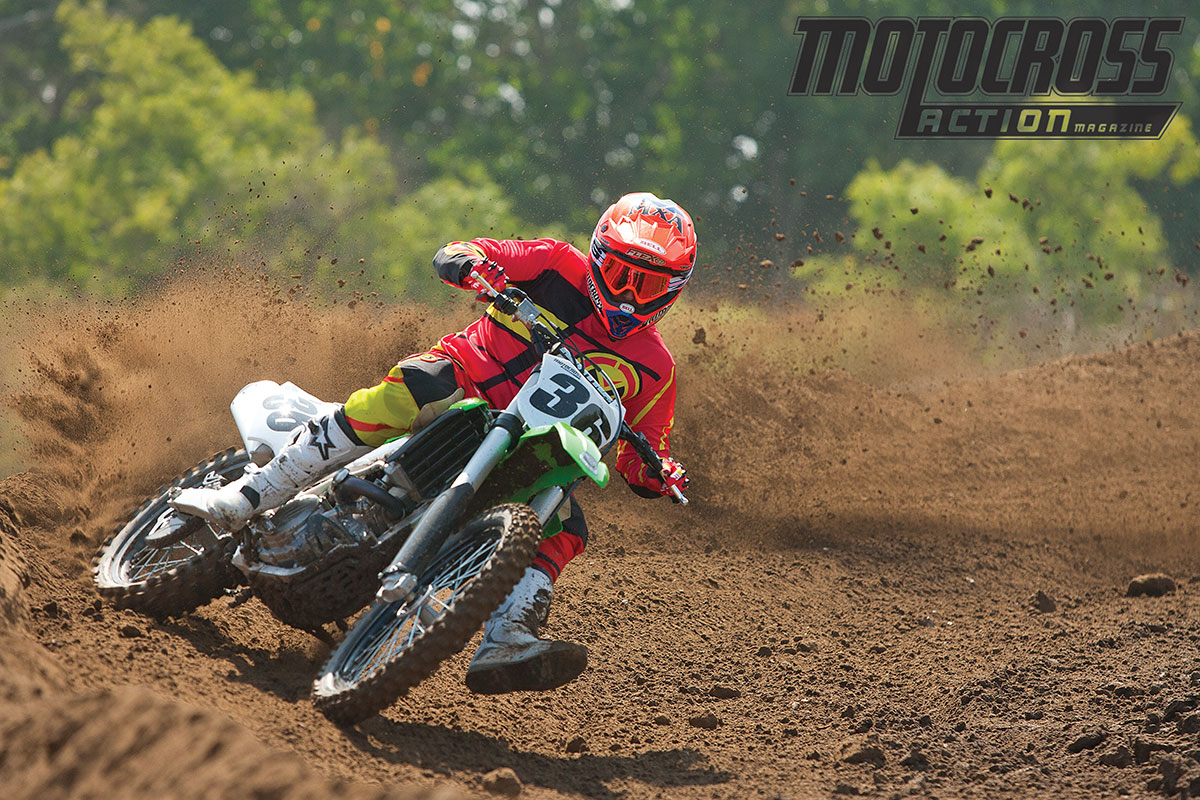
Q: FIRST AND FOREMOST, IS THE 2017 KX450F BETTER THAN THE 2016 KX450F?
A: Yes, but the 2017 changes and differences are more incremental than earth-shattering. Given the typical four-year production run of modern Japanese motocross bikes, of which the current KX450F is only in year two, the engineers’ desire to make significant changes is severely hampered by the budget set by the bean counters. But, Kawasaki’s engineers wanted to make improvements in areas where it was feasible, so they focused their attention on three types of improvements:
(1) Problem areas. This was as simple as fixing peccadilloes exposed in the 2016 model. On the 2017 KX450F, that meant small hardware upgrades, suspect plastic parts, graphics durability and mapping.
(2) Outside suppliers. The easiest parts to make changes to are the ones that come from outside of the Kawasaki factory. For example, the Showa SFF-TAC air forks could be modified by simply sending a memo to Showa detailing what valving Kawasaki wanted in this year’s batch of forks.
(3) Must-dos. If the Kawasaki engineers identified a potential problem and a potential fix, they lobbied for the budget to make that improvement. The 2017 in-house must-dos included new triple clamps, a new rising-rate shock linkage and richer fuel mapping. It’s important to note that the 2016 KX450F was brand new from the axles up. It was a vast improvement over the previously girthy, heavy and clunky 2015 model—to the tune of 7.5 pounds. We wouldn’t have been surprised if Kawasaki had stayed with the 2016 model, thus every update on the 2017 KX450F is icing on the cake.
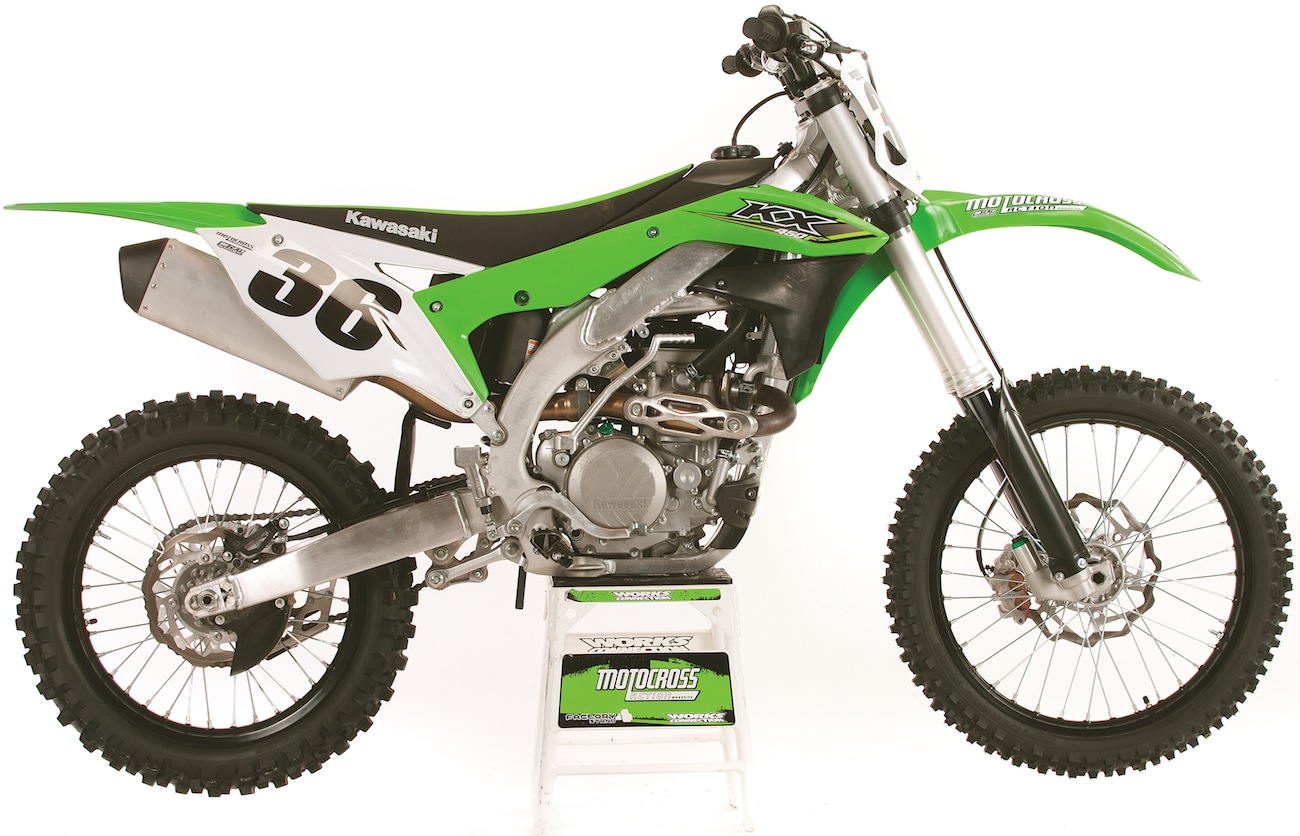 Kawasaki’s engineers put a lot of effort into the KX450F suspension settings for 2017. Plusher forks and a new rising rate are added pluses over the 2016.
Kawasaki’s engineers put a lot of effort into the KX450F suspension settings for 2017. Plusher forks and a new rising rate are added pluses over the 2016.
Q: WHAT DID KAWASAKI CHANGE ON THE 2017 KX450F ENGINE?
A: The short answer is nothing. But, if you liked last year’s engine, you will love this year’s engine a little more. Why? Because the 2016 KX450F had the bad manners to ping when it got hot and pop on deceleration whenever we backed off from full throttle. We were lean in ’16 and we knew it, but it took us 11 different maps to solve the problem, which was as simple as going 15 percent richer at the smallest throttle openings (across the complete rpm range). Although not every 2016 KX450F suffered from the irritating decel pop, it was a big-enough issue that the KX450F engineers developed new mapping for 2017. How did it work? It was a revelation. It ran cleaner, felt crisper and didn’t pop on deceleration. That’s great news, because the Kawasaki mapping tool costs $700.
Last year the KX450F engine got new crankcases, an 8.5mm offset cylinder, improved crankshaft balancer, reshaped piston crown, straighter intake port shape and a direct-connect throttle-body. It’s all good to go for 2017.
Q: HOW MUCH HORSEPOWER DOES THE 2017 KX450F MAKE?
A: 55.76 horsepower at 9000 rpm.
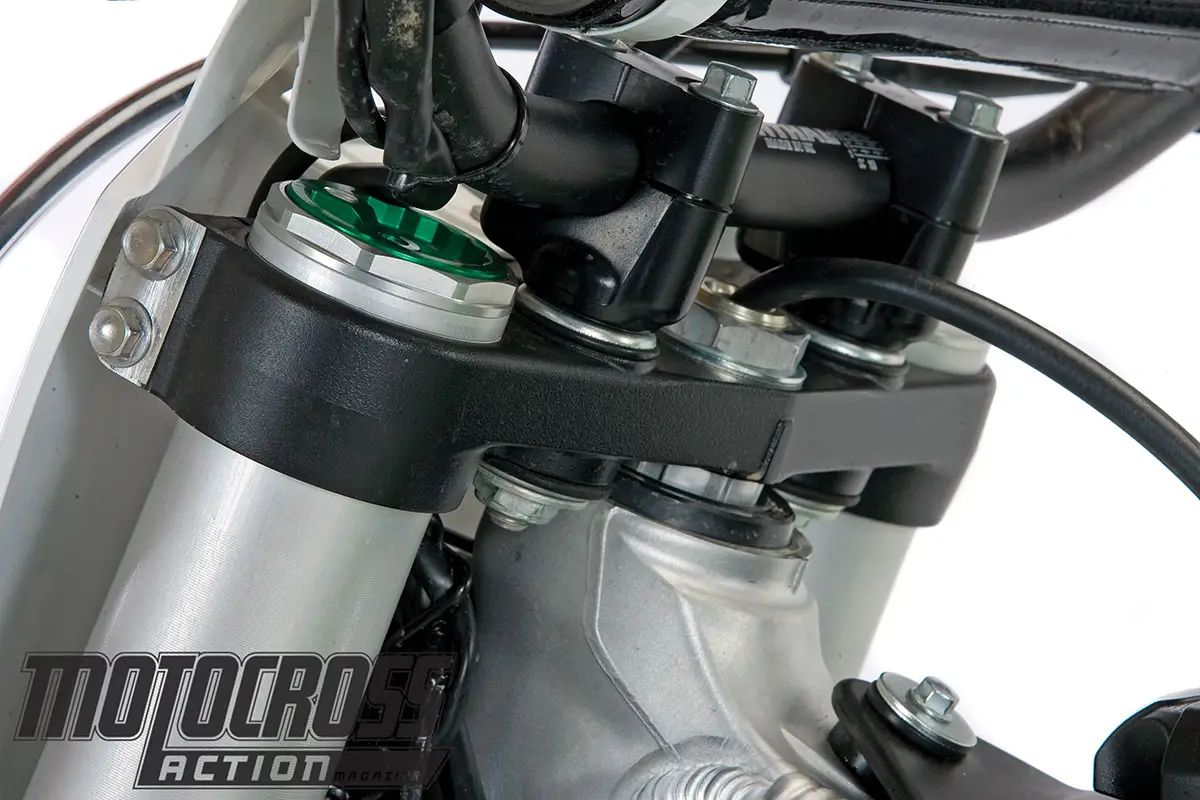
Q: WHAT DID KAWASAKI CHANGE ON THE SHOWA SFF-TAC AIR FORKS?
A: Kawasaki’s 2016 Showa TAC forks were amazingly tunable. Compared to the other 450 air-fork offerings on the Honda and Suzuki, these were the gold standard of air forks. But, the MXA wrecking crew had some issues with them. Here is a quick list.
(1) From a performance point of view, the 2016 forks were really good air forks. We never thought we’d say that about TAC forks. We got them in a sweet spot, but we never really ran the recommended air pressures, always choosing to go lower on the main pressure setting to help the damping work better. Kawasaki’s test riders must have felt the same thing, because this year the recommended pressures are way down. This produces a much more supple feel and more workable settings without having to exceed 200 psi in the balance chamber.
(2) We admit that we don’t have the patience, time or desire to deal with an air pump and a bunch of Shrader valves. Having to set three different air pressures in TAC forks—when we could race a Yamaha with its no-fuss coil spring—doesn’t strike us as progress. Difficult-to-understand fork interfaces do not attract entry-level buyers. And, in most cases, local racers eventually give up the chase for the correct air pressures.
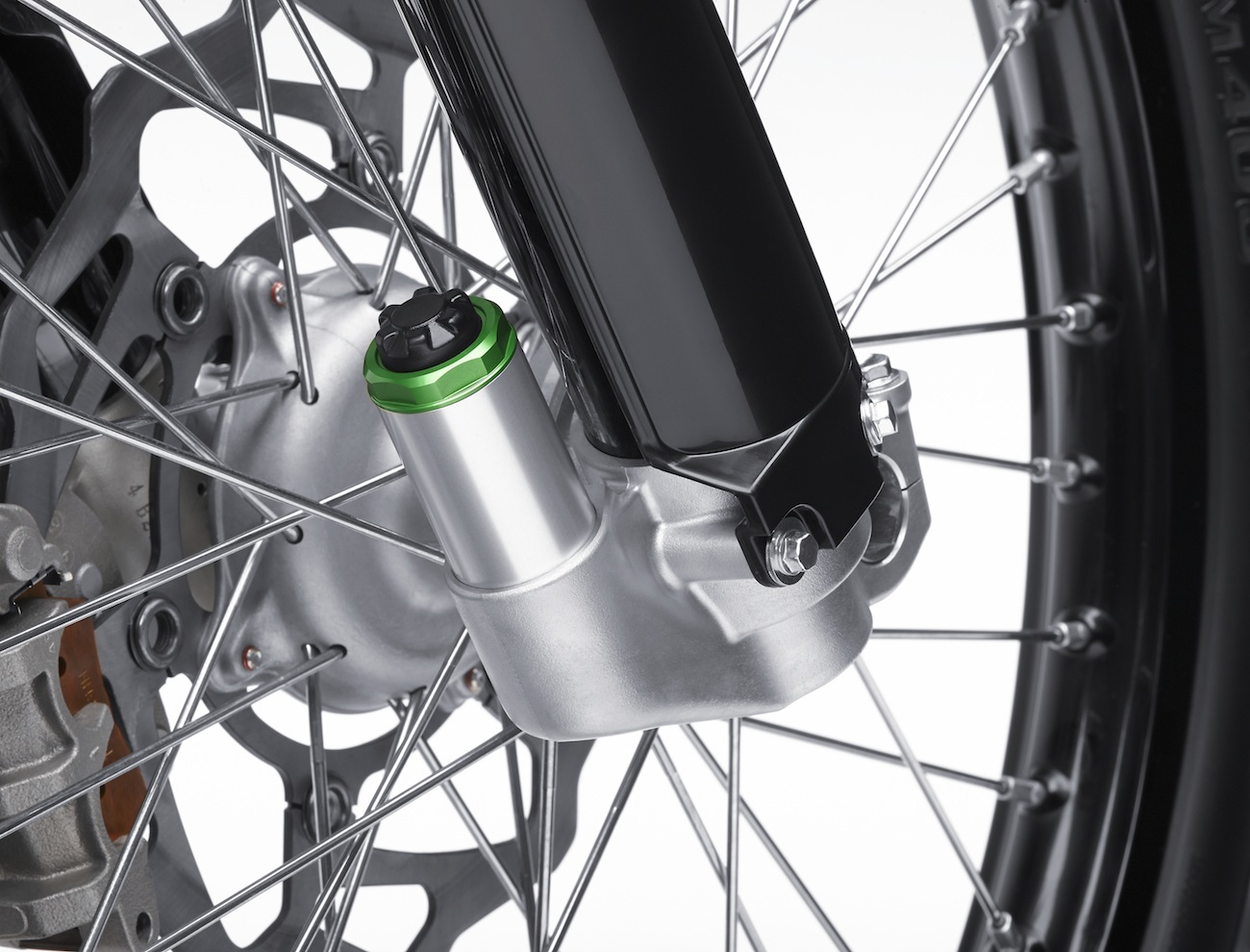
(3) Where most Showa SFF-TAC air-fork users go wrong is by focusing on the main air pressure. The key is the balance chamber. Once you get enough air pressure in the main chamber to hold the fork up for your track conditions, you must alter the balance-chamber pressure to make significant performance improvements. More air in the balance chamber than in the main chamber will make the fork plusher over small bumps, shorten its overall length (affecting the frame geometry) and allow the fork to drop into corners. Less air in the balance chamber than in the main chamber will make the fork ride higher, lengthen it (affecting the frame geometry) and keep the fork from dropping into corners. In the end, there is a perfect ratio of balance pressure to main-chamber pressure—but until you find it, you will struggle.
(4) There is one caveat about the 2017 Kawasaki KX450F air forks—the air valves on the fork caps are reversed for 2017. The valve that put air in the outer chamber last year puts it in the inner chamber in 2017 (and vice versa). When in doubt, there is a pictograph on fork cap to direct your air pump in the right direction.
(5) The top triple clamp has more meat to it for 2017 and additional ribbing underneath for increased rigidity. The bottom triple clamp is larger, stiffer and 2.5mm thicker where it clamps the fork stanchions (from 47mm thick to 49.5mm thick).
Q: WHAT DID KAWASAKI CHANGE ON THE 2017 KX450F SHOCK?
A: Tired of KX450F riders changing the rising-rate linkage and pull rods on the green machines every year, Kawasaki did it for them in 2017. The pull rods are 0.5mm longer, which doesn’t sound like much, but since the pull rods are attached to a more progressive rising-rate bell crank, which will retrofit on the 2016 model, the differences are more than just a silly 0.5mm. The shock spring is different, but not really. Thanks to a higher grade of metal, the 2017 shock spring is lighter than the 2016 version, but the spring rate is unchanged. Perhaps the least noticed change on the 2017 KX450F is that the opening in the swingarm, where the shock goes through, is now larger. This isn’t as much for performance as it is to keep mud and dirt clods from collecting in the tight squeeze between the shock spring and top of the swingarm’s cast front section. A little more room allows dirt to fall away.
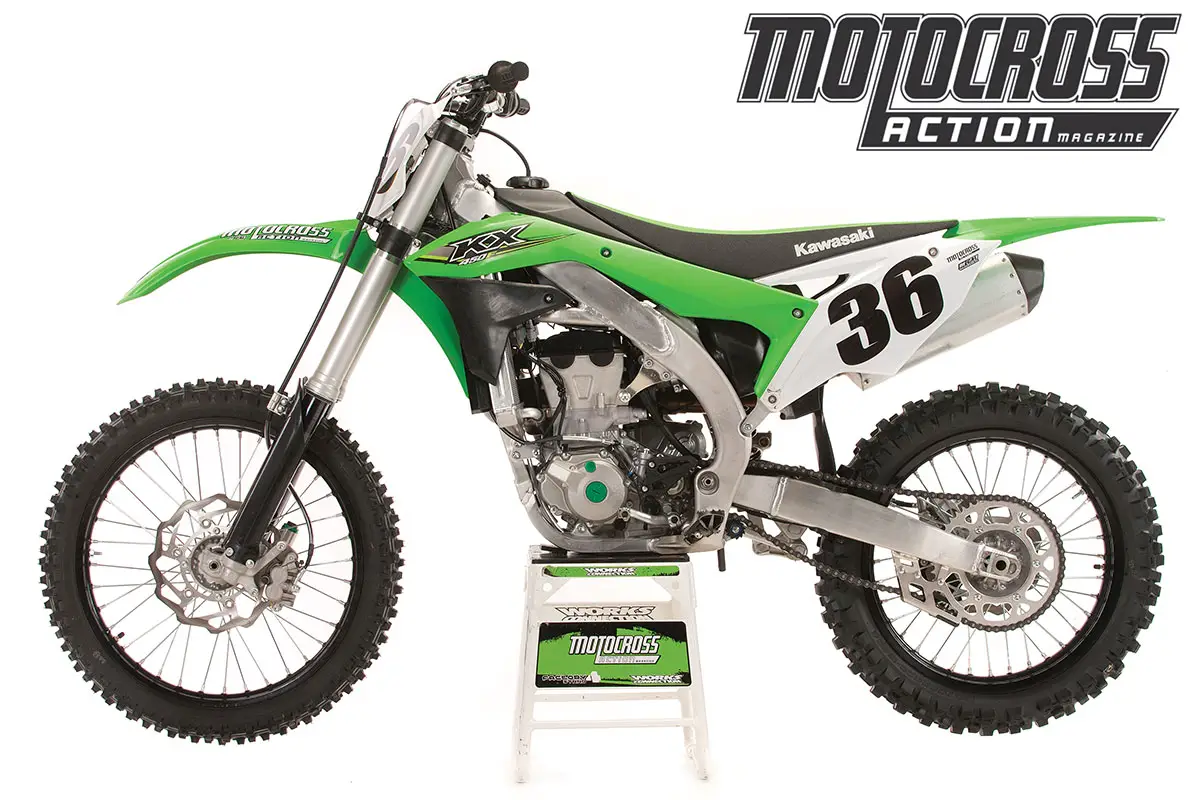
Q: WHAT ELSE DID KAWASAKI CHANGE ON THE 2017 KX450F?
A: There is no doubt that the mapping, fork valving, triple clamps, shock spring and rising rate are the big news, but we would be remiss if we didn’t mention that the radiator shrouds now have in-mold graphics, which means that your KX450F will say “Kawasaki” much longer than in the past. Last year the seat base had a tendency to flex on hard landings. So, Kawasaki completely redesigned the plastic seat base, not only adding longitudinal ribbing but also increasing how far the tab goes under the subframe cross-brace. You won’t be writing home about the final change for 2017, but the washers under the exhaust pipe’s heat shield are now stainless steel instead of fiber.
Q: WHAT DOES THE 2017 KX450F WEIGH?
A: In the Jenny Craig Weight-Loss Challenge, Kawasaki pulled out all the stops in 2016 and got the KX450F down to 231 pounds. That made it the lightest Japanese 450 of 2016. And, nothing they did in 2017 trimmed any fat, so Kawasaki is stuck at 231. For comparison, the 2016 KTM 450SXF weighed only 227 pounds, but will hit the scales at 222 pounds in 2017. Kawasaki’s consolation prize for being lighter than the Yamaha, Suzuki and the all-new 2017 Honda CRF450 is like kissing your sister—when comparfed to KTM and Husqvarna.
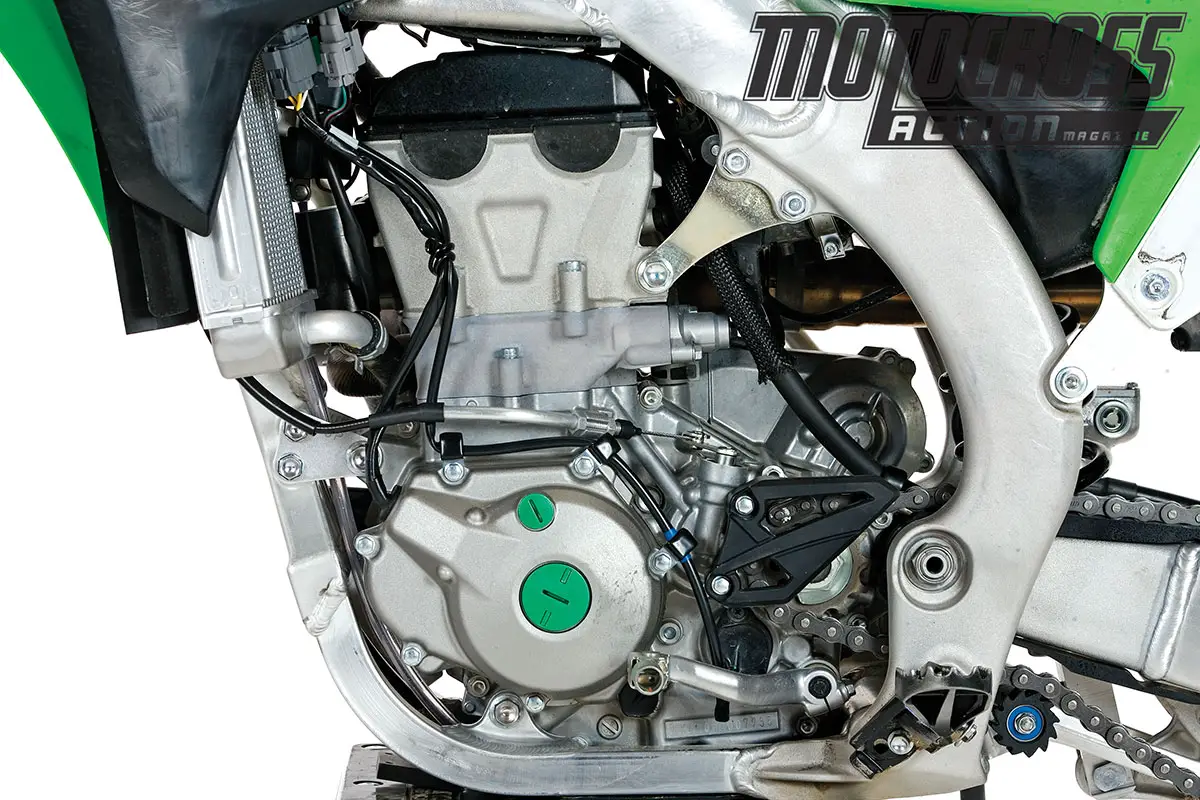
Q: IS THE 2017 ENGINE MORE POWERFUL THAN THE 2016 ENGINE?
A: Yes and no. Yes, it has better EFI mapping, which makes it stronger in transition off the bottom and into the middle. It gains power from low to mid with a big emphasis on the middle, but it isn’t very impressive after the middle. It gives up very quickly on top. As long as you shift at peak it will run up to its potential thanks to improved mapping. Don’t get us wrong; this is a good engine. It’s just not white-knuckle fast.
But, white-knuckle fast is over-rated. The best production engines produce a usable low-to-mid transition and then pull over a long mid-to-top. How much horsepower a bike makes is not as important as how long it makes horsepower. There is no doubt that the KX450F suffers in the broadness category. It is very good in the midrange, but revving it out is a sum-zero game. Going past 9000 rpm is a downward trend. The best way to use the KX450F’s powerband is to run it a gear taller to maximize pull and shift on the 9-grand button.

Q: HOW DOES THE 2017 KX450F HANDLE?
A: Last year every MXA test rider had two incredibly strong opinions about the 2016 KX450F’s handling: (1) It was an unbelievable improvement over the previous KX450F. It wasn’t an upright, cranky bike that required handlebar input to make it turn. It wanted to turn and felt light, agile and quick—and none of those words were ever applied to a Kawasaki KX450F until 2016. (2) However, every test rider complained about looseness on the entrance to corners. Although it didn’t stand up in the corners like previous KXs, it still tended to push the front and wag on the entrance to turns.
For 2017 Kawasaki did two things to make the KX450F turn better. The engineers softened the setup of the SFF-TAC fork to encourage more dive and beefed up the triple clamps to make the steering response more accurate. These two changes did wonders for the Kawasaki chassis.
Q: WHAT DID WE HATE?
A: The hate list:
(1) Rear brake pedal. For our tastes, the rear brake pedal could use more adjustment range. It is easy to run the brake pedal high but almost impossible to run it low—without locking up the rear brake.
(2) Clutch. The stock KX450F clutch is marginal. We run stiffer clutch springs—and you should too.
(3) Airbox. The freestyle-like airbox vent on the left side of the KX450F’s airbox is large enough to allow massive amounts of air into the engine, but also lots of water when cleaning the bike. If water gets on your air filter, it will dissolve the air filter oil. Be careful.
(4) Chain guide. T.M. Designworks should be on every KX450F owner’s speed dial. Here is the number: (541) 772-4161. Take our word for it.
(5) Kickstarter. The 2017 KX450F starts easily, but only if you can get your leg up high enough to get a full kick. Short people will have issues.
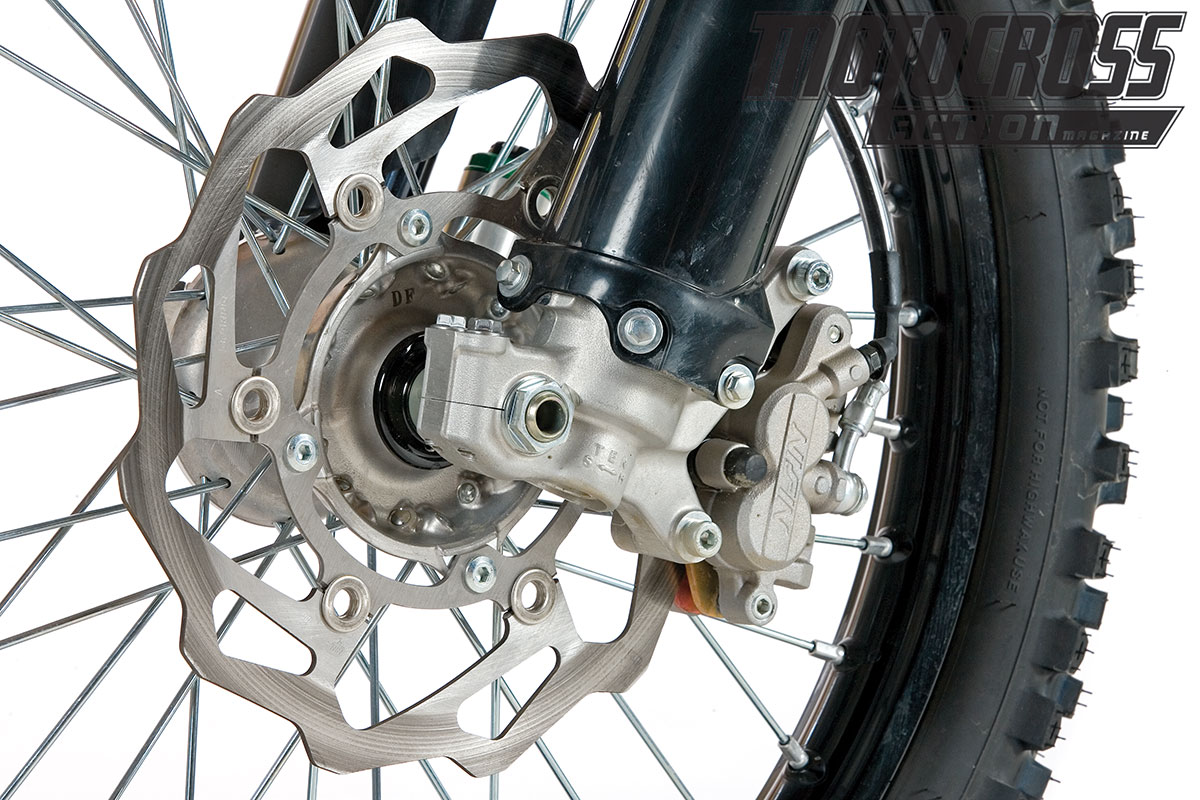
Q: WHAT DID WE LIKE?
A: The like list:
(1) Mapping tool. Kawasaki’s hand-held calibration tool is literally a works part. It allows a computer genius to make every imaginable change to the KX450F mapping. It will store up to 200 different maps (199 of them wrong). Sadly, it costs $700, which is too steep a price for a local racer to pay. Luckily Kawasaki got the map right in 2017.
(2) Launch Control. We run it on concrete and hardpack starts, but not on loamy starts.
(3) Air pump. Kawasaki gives every KX450F buyer a digital air pump. Not supplying an air pump is like not putting coil springs in a normal fork.
(4) Footpegs. The KX450F footpegs can be moved down 5mm if you so desire. No MXA test riders have ever desired to do so.
(5) Tires. The stock rubber is a Bridgestone 403/404 combo. Although overshadowed by the Dunlop MX3Ss, the Bridgestones are very good tires.
Q: WHAT DO WE REALLY THINK?
A: Last year the 2016 Kawasaki KX450F finished third in the MXA 450 shootout. For 2017 they refined the KX450F, but they didn’t redefine it. It’s a good bike, with the “good” adjectives attached to the powerband, brakes, suspension, handling and usability. Great it’s not.

MXA’S KAWASAKI KX450F SETUP SPECS
This is how we set up our 2017 Kawasaki KX450F for racing. We offer it as a guide to help you find your own sweet spot.
SHOWA SFF-AIR TAC FORK SETTINGS
The inherent problem with air forks is that they are speed sensitive. A faster rider will run higher air pressures in the inner and balance chambers than a slower rider, which means that suggested air pressures must always have an asterisk attached that is based on the rider’s speed and weight as well as the track design. We have provided the air-pressure settings below for Vet, Intermediate and Pro riders. These are the setups we ran on the 2017 Kawasaki KX450F for hard-core racing:
Inner spring rate: 138 psi (Vet), 152 psi (Intermediate), 167 psi (Pro)
Outer spring rate: 16.5 psi
Balance spring rate: 160 psi (Vet), 174 (Intermediate), 189 (Pro)
Compression: 13 clicks out (5 clicks out)
Rebound: 12 clicks out
Fork-leg height: 5mm up
Notes: As a general rule, we always ran more air pressure in the balance chamber than in the inner chamber. This lets the forks settle and not ride as high in their stroke, which helps the KX450F turn better.
SHOWA SHOCK SETTINGS
The shock was a surprise. It worked well from day one, and although we went out on several settings and ran the race sag at a relatively low 105mm, we liked the improvements to the rear suspension. We recommend this shock setup on the 2017 Kawasaki KX450F (stock specs are in parentheses):
Spring rate: 5.2 N/m
Hi-compression: 2-1/4 turns out (2 turns out)
Lo-compression: 15 clicks out (13 clicks out)
Rebound: 11 clicks out (13 clicks out)
Race sag: 105mm
Notes: The shock was easy as pie to set up. The rear end had minimal wallowing and worked very well under braking in chop and square-edged bumps.


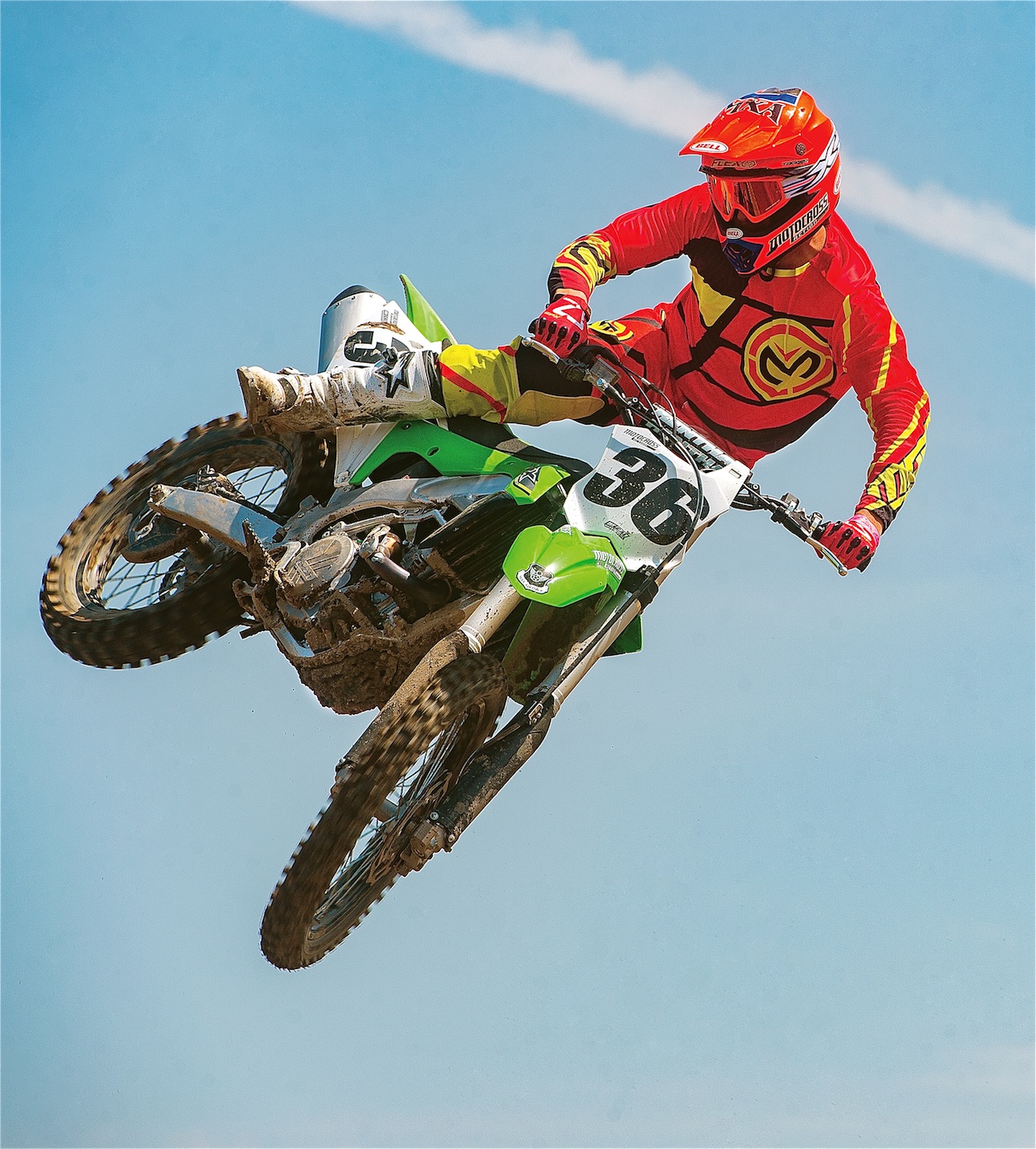


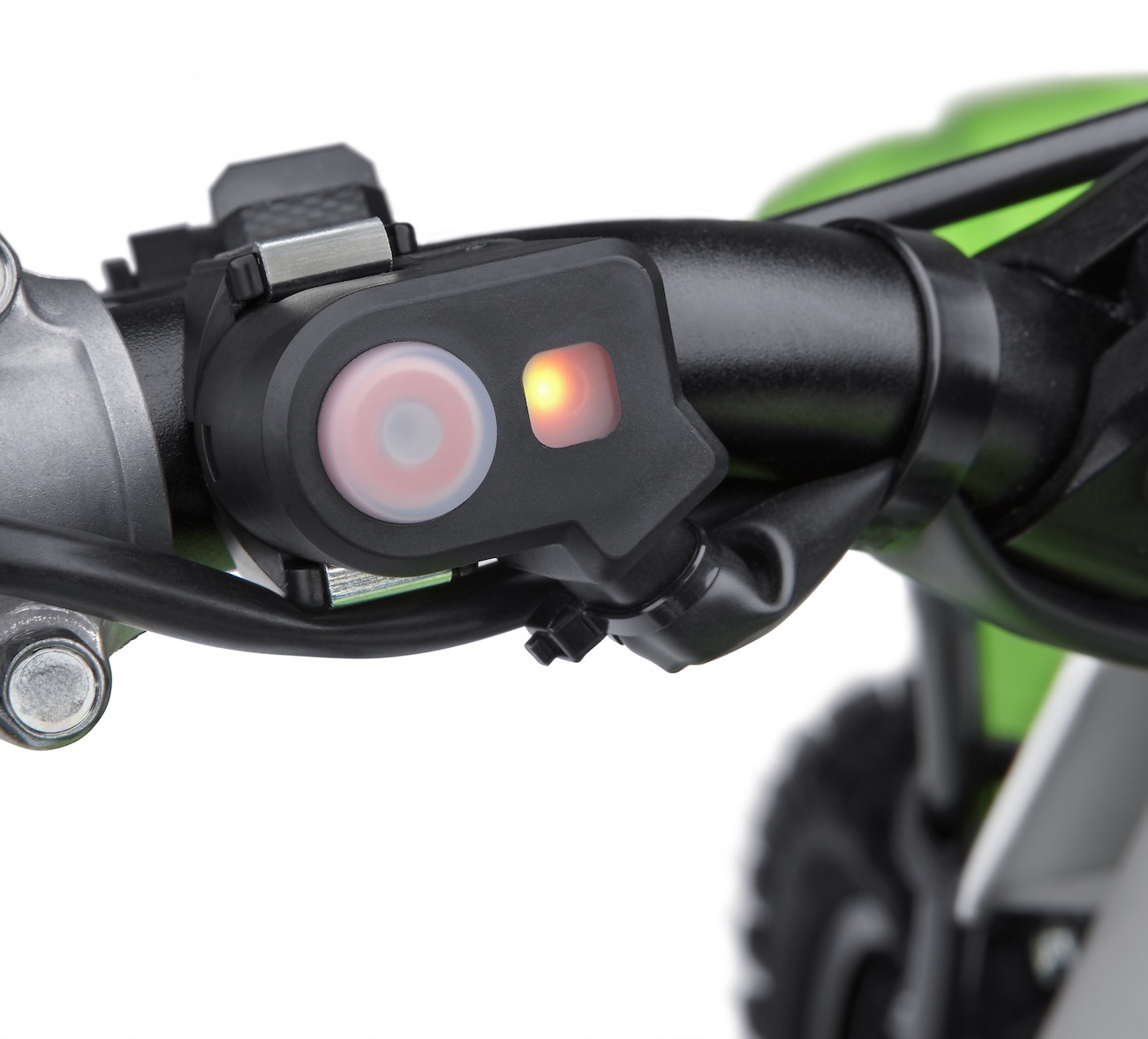



Comments are closed.